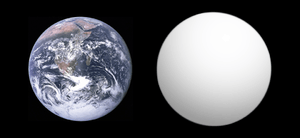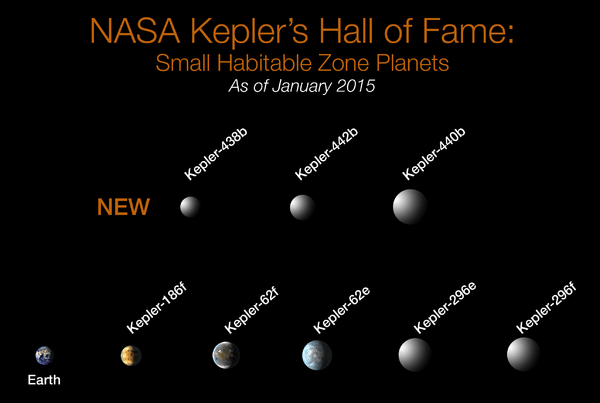Kepler-442b
Kepler-442b (also known by its Kepler Object of Interest designation KOI-4742.01) is a confirmed near-Earth-sized exoplanet, likely rocky, orbiting within the habitable zone of the K-type star[6] Kepler-442, about 1,120 light-years (342 pc) from Earth in the constellation Lyra.[1][2] The planet was discovered by NASA's Kepler spacecraft using the transit method, in which the dimming effect that a planet causes as it crosses in front of its star is measured. NASA announced the confirmation of the exoplanet on 6 January 2015.[1]
Confirmed exoplanet
Kepler-442b is a near-Earth-sized exoplanet with a radius 1.34 times that of Earth. The planet orbits the K-type star[6] Kepler-442 once every 112.3 days.[1][2]
Habitability
The planet was announced as being located within the habitable zone of Kepler-442, a region where liquid water could exist on the surface of the planet. It was described as being one of the most Earth-like planets, in terms of size and temperature, yet found.[1][2]
See also
References
- ↑ 1.0 1.1 1.2 1.3 1.4 1.5 Clavin, Whitney; Chou, Felicia; Johnson, Michele (6 January 2015). "NASA's Kepler Marks 1,000th Exoplanet Discovery, Uncovers More Small Worlds in Habitable Zones". NASA. Retrieved 6 January 2015.
- ↑ 2.0 2.1 2.2 2.3 2.4 2.5 Sample, Ian (7 January 2015). "Kepler 438b: Most Earth-like planet ever discovered could be home for alien life". The Guardian. Retrieved 7 January 2015.
- ↑ 3.0 3.1 3.2 3.3 3.4 3.5 3.6 3.7 3.8 3.9 3.10 Torres, Guillermo; Kipping, David M.; Fressin, Francois; Caldwell, Douglas A.; Twicken, Joseph D.; Ballard, Sarah; Batalha, Natalie M.; Bryson, Stephen T.; Ciardi, David R.; Henze, Christopher E.; Howell, Steve B.; Isaacson, Howard T.; Jenkins, Jon M.; Muirhead, Philip S.; Newton, Elisabeth R.; Petigura, Erik A.; Barclay, Thomas; Borucki, William J.; Crepp, Justin R.; Everett, Mark E.; Horch, Elliott P.; Howard, Andrew W.; Kolbl, Rea; Marcy, Geoffrey W.; McCauliff, Sean; Quintana, Elisa V. (2015). "Validation of Twelve Small Kepler Transiting Planets in the Habitable
Zone". arXiv:1501.01101 [astro-ph.EP].
- ↑ "HEC: Data of Potential Habitable Worlds".
- ↑ Staff (2015). "Planet Kepler-442 b". The Extrasolar Planets Encyclopaedia. Retrieved 11 January 2015.
- ↑ 6.0 6.1 Gilster, Paul (6 January 2015). "AAS: 8 New Planets in Habitable Zone". Centauri-dreams.org. Retrieved 9 January 2015.
External links
|
|---|
| | Disciplines | |
|---|
| | Topics | |
|---|
| Space
missions | Earth satellites | |
|---|
| Mars missions | |
|---|
| Proposed | |
|---|
| Cancelled | |
|---|
|
|---|
| | Related | |
|---|
|
-
 Category Category
-
 Portal Portal
|
|
|
|---|
| Events and
objects | |
|---|
| | Signals | |
|---|
| Extraterrestrial
bodies | |
|---|
| Planetary
habitability | |
|---|
| | Missions | |
|---|
| | Communication | |
|---|
| | Exhibitions | |
|---|
| | Hypotheses | |
|---|
| Related
topics | |
|---|
|
Coordinates:  19h 01m 27.98s, +39° 16′ 48.30″
19h 01m 27.98s, +39° 16′ 48.30″


